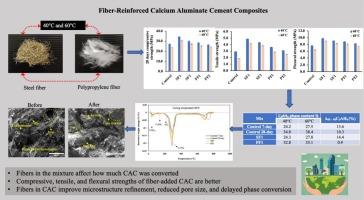钢和聚丙烯纤维增强对不同养护温度下铝酸钙水泥的减缓转化效应的影响
IF 5.9
2区 工程技术
Q1 ENGINEERING, MULTIDISCIPLINARY
引用次数: 0
摘要
铝酸钙水泥(CAC)由于其快速凝固和耐腐蚀性环境而广泛应用于高性能应用。然而,它的长期耐久性往往受到水化相转化的影响,特别是在不同的温度条件下。在较高的固化温度下,从亚稳的CAH10和C2AH8相转变为更稳定但多孔的C3AH6相会导致强度降低。本研究探讨了纤维增强,特别是钢纤维(SF)和聚丙烯纤维(PF)如何减轻高温(40°C和60°C)固化CAC复合材料的这些不利影响。对纤维增强CAC复合材料的力学性能、化学成分和微观组织演变进行了综合评价。实验技术包括流动性、体积密度、孔隙体积、吸水率、抗压强度、直接拉伸强度和抗弯强度测试,并通过x射线衍射(XRD)、热重分析(TGA)和场发射扫描电镜(FESEM)来评估相组成和孔隙结构。纤维的掺入显著提高了CAC复合材料的力学性能,掺量为1%的纤维提高了抗压、直接拉伸和弯曲强度。在40°C时,SF分别提高了约26.5%、67%和27.6%的强度,而PF分别提高了4.4%、24%和16%。然而,在60°C时,由于加速相变和孔隙率的变化,强度的增加不太明显。微观结构分析表明,由于CAC中稳定的C3AH6相变,SF和PF屈服于孔径减小,增强了复合材料的强度和耐久性,固化温度高达60°C。这项研究为纤维增强在高温下减轻CAC转化相关强度损失的潜力提供了新的见解。通过提高机械性能和耐久性,SF和PF为优化高温应用的CAC复合材料提供了一种可持续的方法,为环保、快速成型和高性能建筑材料的发展做出了贡献。本文章由计算机程序翻译,如有差异,请以英文原文为准。

Effect of steel and polypropylene fiber reinforcement on mitigating conversion effects in calcium aluminate cement at varying curing temperatures
Calcium aluminate cement (CAC) is widely used in high-performance applications due to its rapid setting and resistance to aggressive environments. However, its long-term durability is often compromised by hydration phase conversion, particularly under varying temperature conditions. At elevated curing temperatures, the conversion from metastable CAH10 and C2AH8 phases to the more stable, but porous, C3AH6 phase can lead to strength reduction. This study investigates how fiber reinforcement, specifically steel fibers (SF) and polypropylene fibers (PF), can mitigate these adverse effects in CAC composites cured at high temperatures (40 °C and 60 °C). A comprehensive evaluation of fiber-reinforced CAC composites was conducted, focusing on fresh and mechanical properties, chemical composition, and microstructural evolution. Experimental techniques included flowability, bulk density, void vol5me, water absorption, compressive strength, direct tensile strength, and flexural strength tests, complemented by X-ray diffraction (XRD), thermogravimetric analysis (TGA), and field emission scanning electron microscopy (FESEM) to assess phase composition and pore structure. The incorporation of fibers significantly enhanced the mechanical properties of CAC composites, with 1 % fiber addition improving compressive, direct tensile, and flexural strengths. At 40 °C, SF improved these strengths by approximately 26.5 %, 67 %, and 27.6 %, respectively, while PF enhanced them by 4.4 %, 24 %, and 16 %. However, at 60 °C, strength gains were less pronounced due to accelerated phase conversion and changes in porosity. Microstructural analysis reveals both SF and PF yield to reduced pore size, enhancing the strength and durability of the composites, attributed from the stable C3AH6 phase transition in CAC at higher curing temperatures up to 60 °C. This study provides new insights into the potential of fiber reinforcement in mitigating conversion-related strength loss in CAC at elevated temperatures. By enhancing mechanical performance and durability, SF and PF offer a sustainable approach to optimizing CAC composites for high-temperature applications, contributing to the development of eco-friendly, rapid-setting, and high-performance construction materials.
求助全文
通过发布文献求助,成功后即可免费获取论文全文。
去求助
来源期刊

Ain Shams Engineering Journal
Engineering-General Engineering
CiteScore
10.80
自引率
13.30%
发文量
441
审稿时长
49 weeks
期刊介绍:
in Shams Engineering Journal is an international journal devoted to publication of peer reviewed original high-quality research papers and review papers in both traditional topics and those of emerging science and technology. Areas of both theoretical and fundamental interest as well as those concerning industrial applications, emerging instrumental techniques and those which have some practical application to an aspect of human endeavor, such as the preservation of the environment, health, waste disposal are welcome. The overall focus is on original and rigorous scientific research results which have generic significance.
Ain Shams Engineering Journal focuses upon aspects of mechanical engineering, electrical engineering, civil engineering, chemical engineering, petroleum engineering, environmental engineering, architectural and urban planning engineering. Papers in which knowledge from other disciplines is integrated with engineering are especially welcome like nanotechnology, material sciences, and computational methods as well as applied basic sciences: engineering mathematics, physics and chemistry.
 求助内容:
求助内容: 应助结果提醒方式:
应助结果提醒方式:


